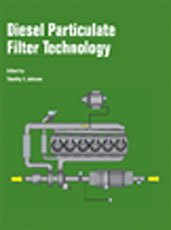Journal Article
Low Cost LEV-III, Tier-III Emission Solutions with Particulate Control using Advanced Catalysts and Substrates
2016-04-05
2016-01-0925
A production calibrated GTDI 1.6L Ford Fusion was used to demonstrate low HC, CO, NOx, PM (particulate mass), and PN (particulate number) emissions using advanced catalyst technologies with newly developed high porosity substrates and coated GPFs (gasoline particulate filters). The exhaust system consisted of 1.2 liters of TWC (three way catalyst) in the close-coupled position, and 1.6L of coated GPF in the underfloor position. The catalysts were engine-aged on a dynamometer to simulate 150K miles of road aging. Results indicate that ULEV70 emissions can be achieved at ∼$40 of PGM, while also demonstrating PM tailpipe performance far below the proposed California Air Resources Board (CARB) LEV III limit of 1 mg/mi. Along with PM and PN analysis, exhaust system backpressure is also presented with various GPF designs.

